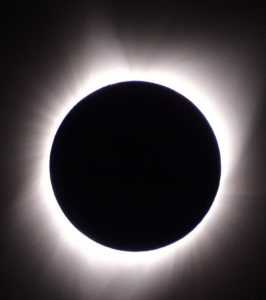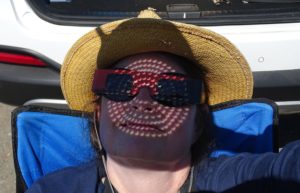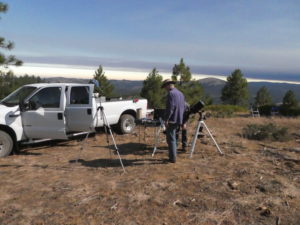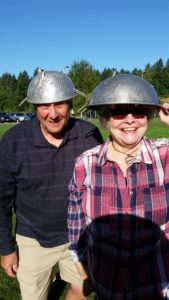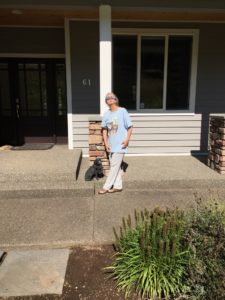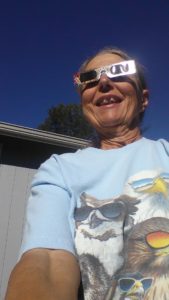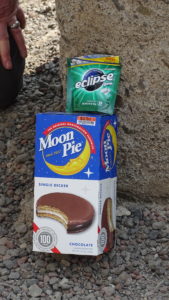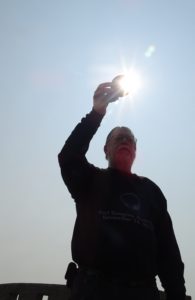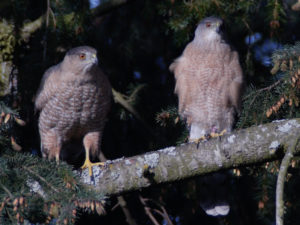CAT WARS, The Devastating Consequences of a Cuddly Killer, has been a science best-seller. It is by Peter P. Marra, head of the Smithsonian Migratory Bird Center and coauthor of the authoritative Birds of Two Worlds: The Ecology and Evolution of Migration, and by prolific nature writer Chris Santella, author of Fifty Places to Go Birding Before You Die, etc.
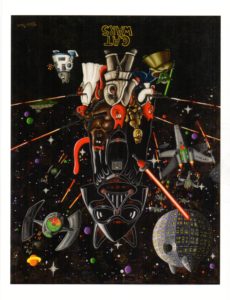
Another vision of Cat Wars
At the beginning of the discussion of CAT WARS, Kay Pullen started us out by asking how many of us had cats, and about half said yes, and all of us have had experience with cats.
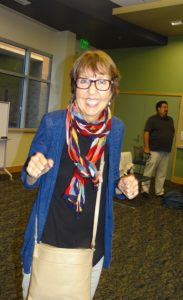
Kay enthuses about our book discussion
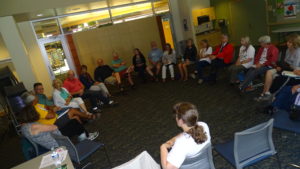
ABC book discussion circle
Points discussed included Donna La Casse on how her cat Stoney, whom many of us know, is able to go birding with her and have a half-outdoor life with leashes, enclosures, and of course her famous backpack. Other similar ideas such as “catios” and enclosed runs were mentioned. Videos were shown of cats trained to leash, including a how-to. These are easily found on YouTube.
Faye introduced the topic of how our culture has changed with regards to dogs, which are now largely controlled, whereas when we were young they were running loose everywhere. Ideas about how to similarly change the culture in the same way with regard to cats were discussed. Ed Pullen discussed toxoplasmosis with his experience as a doctor, so letting the public know more about this underreported, but serious illness for both humans and animals, might help. Kay Pullen pointed out how public sentiment CAN change the culture, using MADD as an excellent example.
Diane mentioned how the cat-loving public needs to be approached as our doing something for the cats, and then Eric Dudley, our resident veterinarian, affirmed that outdoor cats live usually no more than 5 years, whereas indoor cats usually around 15 years. He said that the injuries he sees in his practice to outdoor cats do not seem to convince their owners to keep them indoors, however. Eric also mentioned that it was true that acetaminophen (Tylenol) is a cat-killing poison that doesn’t seem to affect other animals. It’s apparently widely used in Australia, where they are serious about getting their cat problem under control.
The cat problem is critical on islands such as Stephens Island, which is the lead story in the book, but also on the Juan Fernandez Islands off Chile which we’ll hear about next month when Prof. Peter Hodum visits us. Several of us were recently in the island nation of Cuba, and unneutered dogs and cats all run free there, always underfoot and most seemingly unowned. And we all know the sad story of Hawaiian endemics. Art Wang talked about that a little with some experiences of his son Alex who is a researcher there and Alex’s cat. Six of us wore T-shirts with the few remaining Hawaiian endemics pictured.
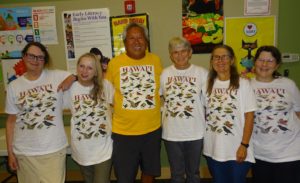
Hawaiian Endemics group — Birds in danger from cats
T-N-R (Trap-Neuter-Release) groups are growing in power, even since the book came out, as a number of major cities (Chicago, New York, etc.) are promoting it as a rat-control system and as a “green” method compared to poison. Some of these jurisdictions are actually moving feral cat colonies purposely into neighborhoods with rat problems. The TNR people really know how to promote their point of view, and this is very scary.
Sheri from PAWS said that the PAWS group she works with in Lynnwood (Donna volunteers there, also) does not endorse TNR and is very concerned with protecting wildlife. She said that may not be the case with all PAWS facilities.
Websites for items mentioned tonight:
“Here Kitty, Kitty,” the movie made about the Wisconsin cat war several years ago is not readily available on video, but excerpts are shown during this interview with the movie maker:
http://wpt.org/Directors-Cut/Video/andy-beversdorf-here-kitty-kitty
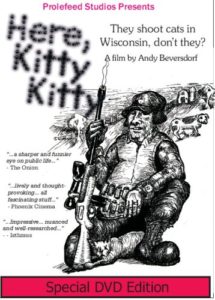
Here, Kitty Kitty movie poster
Print the brochure from the OTHER ABC (American Bird Conservancy). It has tips on how to turn an outdoor cat into an indoor cat and why — for the cat itself, as well as for wildlife:
https://abcbirds.org/program/cats-indoors/take-action/
American Bird Conservancy also has lots of other good stuff on their site. Check out their T-N-R (Trap-Neuter-Release) page about why it’s so bad for birds (and for those cats): https://abcbirds.org/program/cats-indoors/trap-neuter-release/

